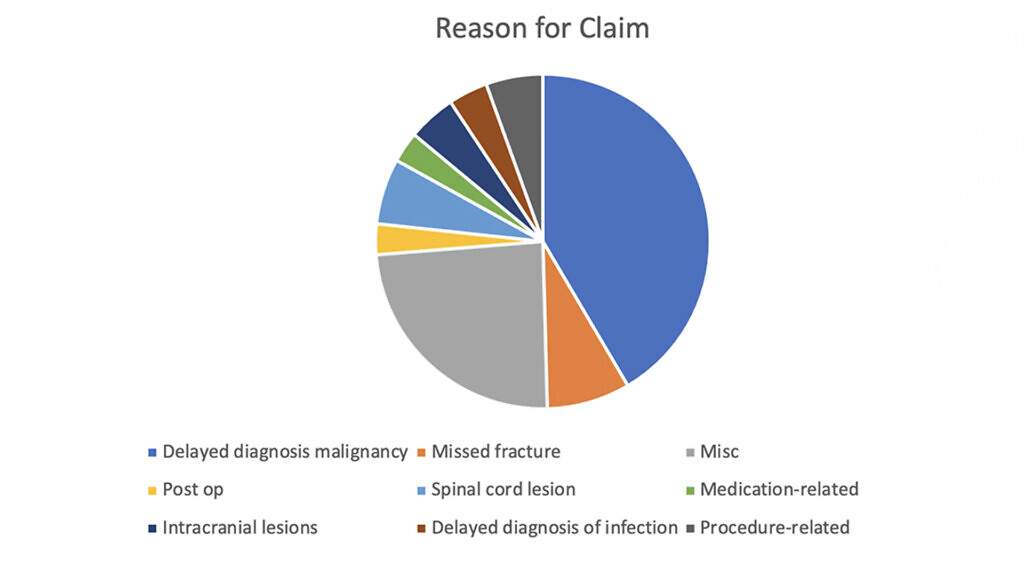Dr Claire Wratten and Greta Barnes analyse clinical negligence claims notified by MDU radiologist members and provide advice on managing risks.
Claims are less frequently made against radiologists than some specialties the MDU covers for private practice – but they remain relatively common and compensation payments can be substantial.
Managing known risks linked to clinical negligence claims is important both to protect patients and to reduce the chance of a claim being successful.

Reasons for claims
Missed diagnosis
The most common reason for a claim was a missed or incorrect diagnosis.
It is generally alleged that if an abnormality had been reported promptly and/or correctly, and then investigated appropriately, the patient would have received treatment more quickly, reducing the period of pain or extent of symptoms experienced, the extent of treatment required and/or disability. It may be alleged that the patient died because of the delay.
Malignancy
The majority of missed diagnosis claims involved a missed tumour. Depending on the length of delay and stage of the malignancy, the alleged consequences ranged from minimal to severe physical disabilities or avoidable or hastened death.
For example, in one case it was alleged the patient would have avoided an above-knee amputation and, in another, that they would have retained their vision.
A claim was also made following an alleged delayed diagnosis of meningioma; the damages agreed were over £600,000, comprising primarily a claim by the patient’s family for dependency on the patient’s income following his death.
The MDU successfully defended over 60% of claims against radiologists identified in this series that followed an alleged delayed diagnosis of malignancy.
Fractures
In some claims where fractures were missed, the impact was minimal, restricted to a longer period of discomfort, because the same treatment would have been required in any event.
For other cases, the oversight resulted in worsening of symptoms, more significant impact on the patient’s day-to day function and additional or more complex treatment being required.
Some also caused deterioration into a separate condition – for example, a case where a missed skull fracture resulted in development of a brain abscess.
Over 70% of claims in which it was alleged that a fracture was missed were successfully defended.
However, one case, in which it was alleged that a missed fracture meant that the patient required a total knee replacement, resulted in payment of a five-figure sum because of the reduced mobility suffered by the patient and resultant care needed prior to correct diagnosis and following the remedial surgery, that could have been avoided.

Spinal cord lesions
There were several cases in which it was alleged that there was a delayed diagnosis of an abnormality of the spinal cord, resulting in neurological damage.
In the vast majority, the diagnosis was cauda equina syndrome, but other diagnoses included spondylolisthesis or arteriovenous malformations. Only 20% of these claims were settled on behalf of the reporting radiologist.
Intracranial lesions
A similar number of claims related to an alleged failure to diagnose an intracranial abnormality on imaging. The diagnoses that were alleged to have been missed included cerebral aneurysms, subarachnoid haemorrhage and ischaemic stroke.
Infections
A few delayed or missed diagnosis claims related to infections, where it was alleged that radiology was incorrectly interpreted and that an infection was missed.
The infections included osteomyelitis, septic arthritis, TB, arachnoiditis and necrotising fasciitis, and only one of these claims was settled on behalf of the reporting radiologist.
Post-operative complications
In these cases, it was alleged that the claimant had suffered a post-operative complication and concerns were raised regarding the reporting of post-operative imaging, resulting in a delay in diagnosis and treatment of the post-operative complication.
Examples include perforation following a gastric band and loosened pedicle screws following spinal surgery.
Procedure-related complications
Radiologists carry out a huge range of different procedures, any of which may result in complications being suffered by the patient.
The range of complications identified in this analysis included infections or haematomas following a biopsy, complications related to coiling of intracerebral aneurysms and nerve injury following nerve blocks or intra-articular injections.
Almost 70% of claims were successfully defended.

Medication-related complications
There were relatively few claims following issues with medication and the majority of cases were following administration of a drug to which the patient was allergic, although there was a claim following contrast-induced renal injury.
Miscellaneous
There were a large number of claims that didn’t clearly fall into a particular category, partly reflecting the wide range of imaging reported on by radiologists.
For example, missed meniscal tears on MRI scanning of the knee, missed renal calculi, missed congenital abnormalities on antenatal scans, missed aortic dissection, failure to diagnose ruptured breast implants and missed foreign bodies.
Compensation costs
This analysis is based on over 230 claims brought against consultant radiologist MDU members working in the independent sector. Approximately three-quarters of these claims were successfully defended, with no payment made to the claimant.
The aim of a compensation payment is to restore the claimant and/or their dependents to the position they would have been in had the negligence not occurred.
When large payments are made, much of the settlement is comprised of funding the future care of seriously injured patients or to compensate them and/or their dependants for loss of earnings and/or pension.
The average damages payment was £77,500, but there was a very large range.
Most common claim
Alleged delayed diagnosis of malignancy was the most common reason for a claim against a radiologist being settled.
Damages paid to the claimant in these cases varied widely, from just over £1,000 for delayed diagnosis of an Ewing sarcoma, to almost £1m for a failure to identify an incidental malignancy on an ultrasound, resulting in a delayed diagnosis and thus a missed chance for curative treatment.
When a compensation payment is made, the paying party is also responsible for settlement of the legal costs incurred by the claimant in bringing the claim. The amount sought for claimant costs increases with the length and complexity of a claim.
However, even in a relatively straightforward claim, these costs can be considerable and can exceed the amount of damages paid to the claimant.
In several cases analysed, the legal costs paid exceeded £100,000, with the largest payment being over £700,000.
The MDU incurs costs investigating and negotiating settlement of claims that settle, but in addition, costs are incurred in the successful defence of a claim – for example, due to instruction of independent experts, solicitors and barristers.
In the claims against radiologists that were successfully defended, the defence costs were often significant – for example, over £180,000 in a case that was won at trial.
These figures demonstrate the need for radiologists to have appropriate indemnity arrangements in place, as even lower-value claims can result in payment of a total sum for damages and legal costs that is considerable.
Dr Claire Wratten is senior medical claims handler and Greta Barnes is senior claims handler at the Medical Defence Union (MDU)



